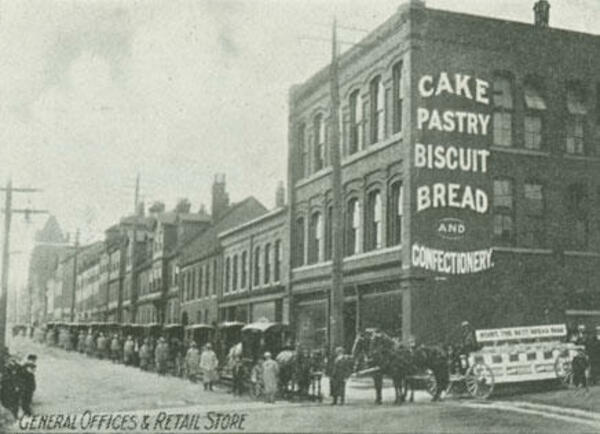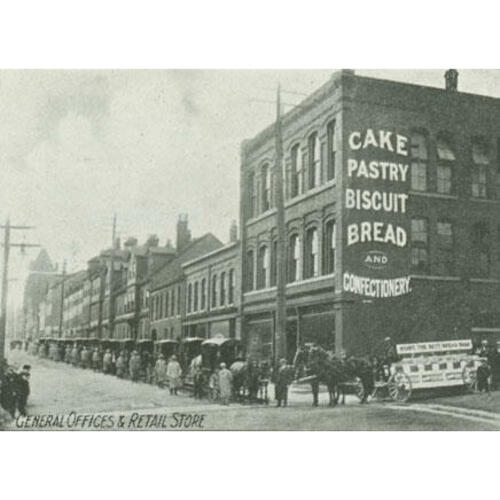
Source: Link
MOIR, WILLIAM CHURCH, businessman; b. 2 May 1822 in Halifax, son of Benjamin Moir and Mary Isabella Church; m. 7 Feb. 1852 Maria Ward in Sackville (Bedford), N.S., and they had four sons and two daughters; d. 5 July 1896 in Halifax.
When William Church Moir’s father died in 1845, he left behind him a prosperous bread bakery in the centre of the city. William transformed his father’s workshop into a factory and thus revolutionized a traditional Halifax trade. He benefited from large bread contracts for the military garrison in Halifax and from a more suitable location on Argyle Street, to which he moved in 1862. He imported American and British steam-baking technology in 1863 and 1864 and, in his own words, “fitted up his large and extensive premises as a Steam Bakery, not only for Baking Hard Bread, Crackers &c., but also for mixing Dough for Soft Bread by machinery.” An agent for R. G. Dun and Company in 1865 described him as “making money rapidly enlarging premises & employing Steam.” The following year Moir formed a partnership with E. C. Twining as Moir and Company, but it was dissolved in 1871. Moir would continue to use the partnership name until 1891, when the business officially became Moir, Son and Company.
Industrialization meant profits for Moir, which in the 1870s he invested in an over-ambitious program of industrial diversification on the Nine Mile River at Bedford, encompassing flour and woodworking mills, paper-box manufacturing, extensive timber lands, and much real estate. About 1873 he and his eldest son, James William, moved into candy production and by the end of the decade this side of the business had become important – W. C. Moir would later tell a government commission that the National Policy of 1879 was more favourable to confectionery than to flour milling or bread baking. Having expanded too rapidly, the Moirs were forced in 1881 to suspend payment. The business was assigned to James R. Graham, a Halifax alderman and former manager of the Bedford operation. However, the firm survived both this set-back and several fires, including one that destroyed its Halifax factory ten years later.
Industrialization also brought Moir into conflict with the journeymen bakers of Halifax. In 1868 they had struck in an attempt to raise their wages and curtail night work in the trade, but they were unable to influence Moir, who used strike-breakers and tried to secure the use of British soldiers. In 1884 the Amalgamated Trades Union mounted a novel, but ultimately unsuccessful, province-wide boycott of Moir’s products to protest long hours of labour in his factory. Although the bakers’ union achieved a nine-hour day in 1890, this gain was nullified the following year when Moir discharged unionized employees and replaced them with more compliant workers. The conditions in the factory were widely publicized in testimony by injured and overworked men and children before the royal commission on the relations of labour and capital in Canada when it visited Halifax in 1888.
When he died, William Church Moir was widely hailed as one of the most energetic and enterprising businessmen in Halifax. His factory, which employed 265 workers, produced 11,280 loaves of bread every day and made more than 500 types of confectionery, which were sold in the national market. The firm had survived labour struggles, fires, and a brush with bankruptcy to become one of the few Maritime industries able to withstand the pressures that increasingly brought the economy of the region under the control of central Canadian capital. Moir, Son and Company had benefited from the inability of workers to reform the chronic overwork in the industry, the natural advantage enjoyed by the firm in local markets for perishable products, the large military market, and the generous tax concessions granted to the company by the city of Halifax. But not least among the reasons for the company’s survival was the entrepreneurial drive and tenacity of its founder. His single-minded pursuit of capital and profits suggests both the achievements and the costs of 19th-century industrial capitalism in Canada.
Baker Library, R. G. Dun & Co. credit ledger, Canada, 12: 694. NA, RG 8, I (C ser.), 1777: 186 (mfm. at Can., Parks Canada, Halifax Defence Complex). PANS, MG 3, 1864(A)–72; RG 5, P, 126, 1865; RG 35-102, ser.39, 1880–1909. Can., Royal commission on labour and capital, Report, Evidence – Nova Scotia, 12–14, 176–77, 180. N.S., Statutes, 1877, c.81; 1880, c.52. Acadian Recorder, 1867–1902, esp. 13 Aug., 23 Sept. 1884; 28 Jan. 1891; 6 July, 22 Dec. 1896. Halifax Daily Echo, 1896. Halifax Evening Reporter, 1864. Halifax Herald, 6 July 1896. Morning Chronicle (Halifax), 31 Dec. 1877. Morning Herald (Halifax), 1881. Morning Journal and Commercial Advertiser (Halifax), 1859. Novascotian and Weekly Chronicle, 11 July 1896. Presbyterian Witness, and Evangelical Advocate, 1867. Halifax and its business: containing historical sketch, and description of the city and its institutions . . . (Halifax, 1876), 79–80. L. D. McCann, “Staples and the new industrialism in the growth of post-confederation Halifax,” Acadiensis (Fredericton), 8 (1978–79), no.2: 47–79. Ian McKay, “Capital and labour in the Halifax baking and confectionery industry during the last half of the nineteenth century,” Labour (Halifax), 3 (1978): 63–108.
Cite This Article
Ian McKay, “MOIR, WILLIAM CHURCH,” in Dictionary of Canadian Biography, vol. 12, University of Toronto/Université Laval, 2003–, accessed December 26, 2025, https://www.biographi.ca/en/bio/moir_william_church_12E.html.
The citation above shows the format for footnotes and endnotes according to the Chicago manual of style (16th edition). Information to be used in other citation formats:
| Permalink: | https://www.biographi.ca/en/bio/moir_william_church_12E.html |
| Author of Article: | Ian McKay |
| Title of Article: | MOIR, WILLIAM CHURCH |
| Publication Name: | Dictionary of Canadian Biography, vol. 12 |
| Publisher: | University of Toronto/Université Laval |
| Year of publication: | 1990 |
| Year of revision: | 1990 |
| Access Date: | December 26, 2025 |



